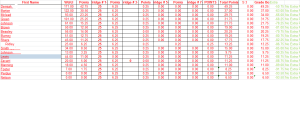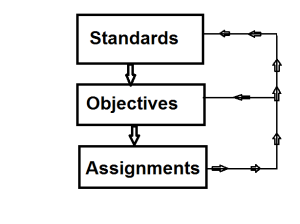I have just completed the online course outlined by Georgia Virtual Learning and obtained certification in all five areas listed below:
1)Participate
2)Navigate
3)Communicate
4)Create
5)Evaluate
Archive for the ‘Ga. Virtual Learning’ Category
Georgia Virtual Online Training
May 16, 2014QR Codes and Engineering Professions
May 15, 2014Students love to research and are very inquisitive. When the students see these QR codes posted around the classroom, they use their cell phones to scan the codes and they are linked immediately to the website. These QR codes are a series of engineering professions. This is one way to integrate technology into the classroom.
Reflection
May 14, 2014 My Teaching Philosophy
1.As I reflect on my teaching strategies and lessons, most of my students were 80 to 90% fully engaged. There will always be some goof-offs independent of how interesting or engaging an activity is viewed.
2. During my instructions, my instructional goals were met and evidence was the completion of a project. The students learned what was expected; for example learning how to solve problems and work in groups.
3.Sometimes during class time, instructional goals were changed to compensate for a piece of equipment not working properly or there was a break in class time due to assemblies, fire drills, and other alarms but 98% of the time the instructions did not alter.
4.If I had the opportunity to reteach this year again, to this same group of students, the only thing I would do differently would be to request smaller classes, and have the students work more in smaller groups.
Below is an evaluation rubric for assessing student work
Assessment Rubric
Data
May 14, 2014
This data is being used to track the students performance on a series of formative assessments .You can quickly notice that Demiah has 171 points to Perdue and Nelson 0 points on the doccumentation of these point system. The students on the upper third of the chart would be considered independent students and would be your high achievers and vice versa. Instruction would be changed to compensate for the difference.
Objectives for Competency # 4
May 14, 2014
(a) Identify appropriate modeling techniques.
(b) Select and apply appropriate materials, tools, and processes for prototype development.
(c) Evaluate effectiveness of prototyped solution and modify as needed.
Objectives for Competency # 3
May 14, 2014 (a) Describe the role of mathematics and science in technological development.
(b) Construct a mathematical model for a known technological system.
(c) Explain the scientific principles behind a basic machine.
Objectives for Competency # 2
May 14, 2014a)Explain various measuring systems and their base units.
(b) Demonstrate applications of precision measuring instruments to describe parts and inspect artifacts.
(c) Perform keyboard functions using a scientific, hand-held calculator.
(d) Create an Excel spreadsheet to perform basic arithmetic and algebraic computations on data related to an engineering design problem.
(e) Use laboratory tools and equipment to determine the properties of materials.
Objectives for Competency # 1
May 14, 2014(a) Describe the role of problem identification, problem definition, search, constraints, criteria, alternative solutions, analysis, decision, specification, and communication as activities comprising the engineering design process.
(b) Organize the iterative processes necessary to develop and optimize a design solution.
(c) Apply engineering design to the solution of a problem.
Rubrics And Compentencies
May 14, 2014 Basic Fundamentals of CNC Mill Operations
Basic Fundamentals of CNC Mill Operations
Competencies
Competency 1– Students will demonstrate the engineering design process.
Competency 2 – Students will solve problems using basic engineering tools and resources.
Competency 3– Students will use visual and verbal communication to express basic design elements
Competency 4– Students will demonstrate prototype development.
Students will be given the standards and be given a list of objectives which are followed by a set of assignments and assessments. Sometimes students can do assignments that are projected based without knowing that they are covering are learning desiginated standards.This is one of the more easier ways to to assess students when they complete the projects.
Data Driven Instruction
May 14, 2014The Data Driven Instruction, Analytics, Reporting Tools quest examines the use of data driven instruction and the role of analytics and reporting tools within successful online instruction.
The data shows that can instructor can plan accordingly based on the size of his class.
Also shown in the student progress is that as instructions was given over a 2 week period , there was a gradual increases of students making better grades and at two point, there peaks of performance. The instructor can review his teaching strategies and find what causes these increases and try to repeat those strategies. Also, he may review his teaching strategies during the time there were below average performances and improver there also.